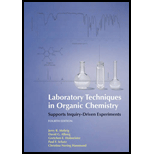
Interpretation:
Whether the two substances in the TLC analysis are identical or not should be determined. Also, the additional experiment that can be performed to identify them if they are not identical should be determined.
Concept introduction:
Thin-layer chromatography (TLC) is an analytical technique used to identify whether two compounds are identical or not and also to determine the number of compounds in a mixture.
In TLC, glass, metal, or plastic plates are used that are coated with a thin layer of adsorbent, which acts as a stationary phase. The stationary phase usually used is polar silica gel. The mobile phase is a pure solvent or a mixture of solvents. It is also known as a developing agent. Mostly nonvolatile solid organic samples are analyzed by thin-layer chromatography. However, TLC cannot be used for volatile liquid compounds because it leads to loss of the sample by evaporation from the TLC plate.
In TLC analysis, a small amount of the mixture to be separated is dissolved in a suitable solvent and applied on the TLC plate. Then the plate is placed in a closed chamber immersed in the mobile phase called the developing solvent. The solvent rises through the stationary phase by capillary action. As the solvent rises the plate, the sample is distributed between the mobile phase and the stationary phase on the basis of their retention values. The more the compound interacts with the stationary phase, the more slowly it moves on the TLC plate. When silica gel is the stationary phase, the developing solvent moves nonpolar substances up the plate most rapidly. As the chromatogram develops, polar substances travel up the plate slowly.
The retention factor
Explanation of Solution
When two samples have identical
Also if TLC analyses are done subsequently with different developing solvents, then it can help to conclude that the samples are different compounds if different
Want to see more full solutions like this?
Chapter 18 Solutions
Laboratory Techniques in Organic Chemistry
 ChemistryChemistryISBN:9781305957404Author:Steven S. Zumdahl, Susan A. Zumdahl, Donald J. DeCostePublisher:Cengage Learning
ChemistryChemistryISBN:9781305957404Author:Steven S. Zumdahl, Susan A. Zumdahl, Donald J. DeCostePublisher:Cengage Learning ChemistryChemistryISBN:9781259911156Author:Raymond Chang Dr., Jason Overby ProfessorPublisher:McGraw-Hill Education
ChemistryChemistryISBN:9781259911156Author:Raymond Chang Dr., Jason Overby ProfessorPublisher:McGraw-Hill Education Principles of Instrumental AnalysisChemistryISBN:9781305577213Author:Douglas A. Skoog, F. James Holler, Stanley R. CrouchPublisher:Cengage Learning
Principles of Instrumental AnalysisChemistryISBN:9781305577213Author:Douglas A. Skoog, F. James Holler, Stanley R. CrouchPublisher:Cengage Learning Organic ChemistryChemistryISBN:9780078021558Author:Janice Gorzynski Smith Dr.Publisher:McGraw-Hill Education
Organic ChemistryChemistryISBN:9780078021558Author:Janice Gorzynski Smith Dr.Publisher:McGraw-Hill Education Chemistry: Principles and ReactionsChemistryISBN:9781305079373Author:William L. Masterton, Cecile N. HurleyPublisher:Cengage Learning
Chemistry: Principles and ReactionsChemistryISBN:9781305079373Author:William L. Masterton, Cecile N. HurleyPublisher:Cengage Learning Elementary Principles of Chemical Processes, Bind...ChemistryISBN:9781118431221Author:Richard M. Felder, Ronald W. Rousseau, Lisa G. BullardPublisher:WILEY
Elementary Principles of Chemical Processes, Bind...ChemistryISBN:9781118431221Author:Richard M. Felder, Ronald W. Rousseau, Lisa G. BullardPublisher:WILEY





